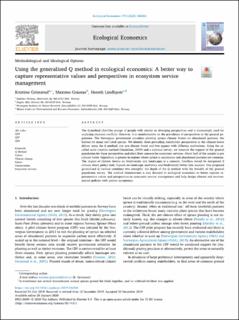| dc.contributor.author | Grimsrud, Kristine | |
| dc.contributor.author | Graesse, Maximo | |
| dc.contributor.author | Lindhjem, Henrik | |
| dc.coverage.spatial | Norway | en_US |
| dc.date.accessioned | 2020-04-21T08:59:42Z | |
| dc.date.available | 2020-04-21T08:59:42Z | |
| dc.date.created | 2020-04-20T13:06:23Z | |
| dc.date.issued | 2020-01-20 | |
| dc.identifier.citation | Ecological Economics. 2020, 170 (April), . | en_US |
| dc.identifier.issn | 0921-8009 | |
| dc.identifier.uri | https://hdl.handle.net/11250/2651810 | |
| dc.description.abstract | The Q-method identifies groups of people with similar or diverging perspectives and is increasingly used for analysing resource conflicts. However, it is uninformative on the prevalence of perspectives in the general population. The Norwegian government considers planting spruce climate forests on abandoned pastures, the habitat for many red listed species. We identify three prevailing stakeholder perspectives in the climate forest debate using the Q method; one pro climate forest and two against with differing motivations. Using the so-called scale creation method (Danielson, 2009) and a national survey, we measure the support of the general population for these perspectives and elicit their concern for ecosystem services. About half of the sample is pro climate forest. Opposition is greater in regions where spruce is uncommon and abandoned pastures are common. The impact of climate forests on biodiversity and landscapes is a concern. Conflicts would be dampened if climate forest policy took impacts on landscape aesthetics and biodiversity better into account. Our proposed generalised Q method combines two strengths: the depth of the Q method with the breadth of the general population survey. The method demonstrates a way forward in ecological economics to better capture representative values and perspectives in ecosystem service management and help design climate and environmental policies with greater acceptance. | en_US |
| dc.language.iso | eng | en_US |
| dc.publisher | Elsevier | en_US |
| dc.rights | Navngivelse-Ikkekommersiell-DelPåSammeVilkår 4.0 Internasjonal | * |
| dc.rights.uri | http://creativecommons.org/licenses/by-nc-sa/4.0/deed.no | * |
| dc.subject | Climate change | en_US |
| dc.subject | Klimaendringer | en_US |
| dc.subject | Ecosystem services | en_US |
| dc.subject | Økosystemtjenester | en_US |
| dc.subject | Forest | en_US |
| dc.subject | Skog | en_US |
| dc.subject | Abandoned pastures | en_US |
| dc.subject | Q method | en_US |
| dc.subject | Carbon sequestration | en_US |
| dc.subject | Karbonfangst | en_US |
| dc.title | Using the generalised Q method in ecological economics: A better way to capture representative values and perspectives in ecosystem service management. | en_US |
| dc.type | Peer reviewed | en_US |
| dc.type | Journal article | en_US |
| dc.description.version | publishedVersion | en_US |
| dc.rights.holder | © 2020 The Authors. Published by Elsevier B.V. This is an open access article under the CC BY license (http://creativecommons.org/licenses/BY/4.0/). | en_US |
| dc.subject.nsi | VDP::Samfunnsvitenskap: 200::Økonomi: 210 | en_US |
| dc.source.pagenumber | 15 | en_US |
| dc.source.volume | 170 | en_US |
| dc.source.journal | Ecological Economics | en_US |
| dc.source.issue | April | en_US |
| dc.identifier.doi | https://doi.org/10.1016/j.ecolecon.2019.106588 | |
| dc.identifier.cristin | 1807125 | |
| dc.relation.project | Norges forskningsråd: 235560 | en_US |
| dc.relation.project | Norges forskningsråd: 268243 | en_US |
| cristin.ispublished | true | |
| cristin.fulltext | original | |
| cristin.qualitycode | 1 | |

